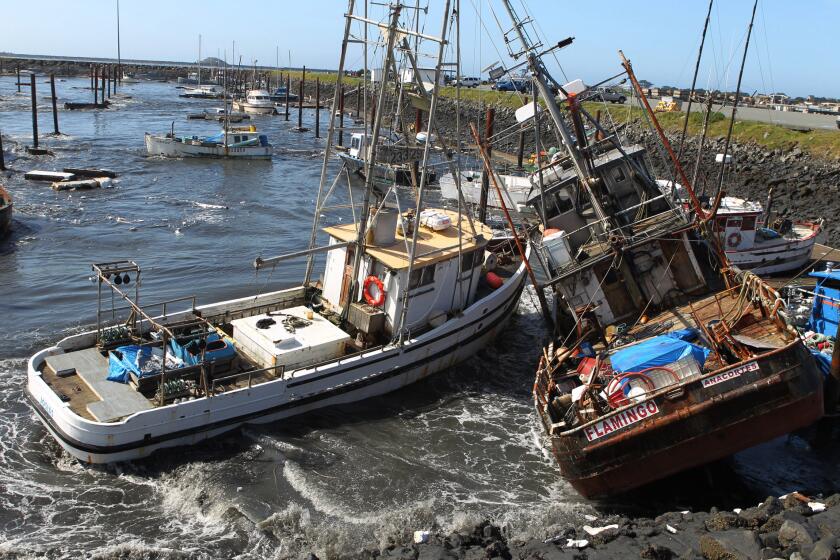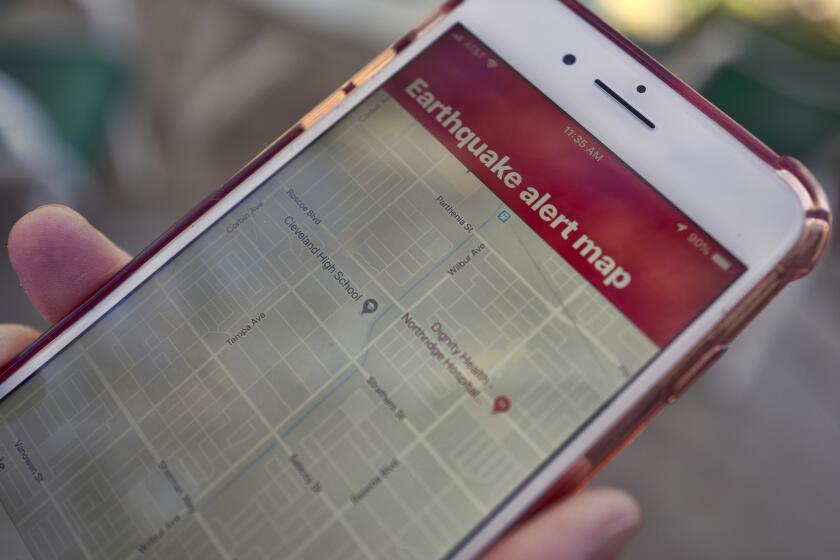BAY AREA QUAKE : Some Bay Area Landfills Simply Shook Off Quake
- Share via
SAN FRANCISCO — Some of the heaviest damage in the Bay Area earthquake was to areas like San Francisco’s Marina District that were constructed on landfills. At the same time, entire suburbs built on what once was swampland survived.
The point, according to scientists and engineers studying what happened to structures on the many landfills around the bay, is that it depends on how the fill is done.
“People have the misconception that landfill is a necessarily dangerous condition. That is not true,” said Raymond Seed, a professor of geology at UC Berkeley.
In addition to causing widespread damage in the Marina District, the list of landfill damage done by the 7.1-magnitude quake includes San Francisco’s Embarcadero Freeway, now closed to traffic.
At Oakland International Airport, a boil made of sand and water 30 feet in diameter pushed up through the asphalt on a runway, while in San Mateo, a freeway overpass remains shut after last week’s violent earthquake caused it to subside.
On the other hand, Seed and others studying the landfill problem point to places like Foster City, a suburb long derided by locals as the place most likely to sink when a big quake hit. But when the quake came last week, the city fared well.
Scientists and engineers say what happened there reaffirms what they long have known about the right and wrong ways of filling in land.
Foster City was built on more than 18 million cubic yards of fill laid in the late 1950s and has grown steadily ever since. What sets the Foster City work apart from that done at numerous other sites around San Francisco Bay Area is that the fill was compacted and dried even before it was brought to the site.
One way of drying out fill is to insert a huge, vibrating piece of machinery that shakes the fill so that it settles into a solid mass. Another way is to tamp it, using huge weights of 50 tons and dropping them 30 feet or more.
Landfill is spread along the waterfront all around the bay. In a large earthquake, poorly compacted landfill “turns into a heavy fluid, like Jell-O before it sets,” said Robert Darragh, geologist for the engineering firm of Dames & Moore in San Francisco. The process is called liquefaction. Loose, wet and sandy soil combines to form a quicksand-like material.
Japanese experts are developing a technique for compacting soil subject to liquefaction. Columns of gravel then are inserted into the ground so that when a quake hits, water can escape up the columns to the surface without liquefying the soil.
Although no such high-tech solutions were used in Foster City, officials seemed a bit surprised at how well their city fared.
“Was it a fluke or was it because we have done something? I don’t know,” City Engineer David N. Valkenaar of Foster City said. “We had some pretty good shaking here, I know that.”
As it turned out, there were more than 200 quake-related calls from jittery residents. Glass shattered and dishes fell. There was some damage to underground utility lines.
“I thought there probably would be some cracking of the levees around Foster City,” said Manuel Bonilla, a U.S. Geological Survey geologist who once worked on a report that predicted levees that protect the city might crack in an earthquake.
Throughout the Bay Area, locations that engineers had thought would crumble survived. In San Francisco’s Chinatown, for example, building after building is made of unreinforced masonry. Such structures are known to be unstable in earthquakes.
“I expected to find more damage than we found, a lot more,” said Don Chan, an assistant building inspector in San Francisco. As it turned out, he went into an apothecary and found that although the building was masonry, not one of the large but lightweight boxes of medicinal herbs had fallen to the ground.
But what most San Franciscans forgot long ago was that China Basin, the portion of the financial district closest to the waterfront, and the area around what now is the Marina District were among the hardest-hit sections of town during the great earthquake of 1906.
The sames areas, all built on landfill, were hard-hit last week. The Embarcadero Freeway runs along the waterfront and may have been damaged as a result of soil becoming liquefied, said Thomas L. Holzer, a USGS geologist. (Holzer said the collapsed portion of the Nimitz Freeway in Oakland was not built on landfill.)
Like Foster City, the Marina District of San Francisco was swampland a century ago. After the 1906 earthquake, developers filled it in with untreated mud from the bay floor. By 1915 when the city hosted the Pan-American Exposition, the Marina was one of the city’s finest residential neighborhoods.
Construction techniques commonly used in the Marina also led to destruction. Most houses there sit atop garages and have large windows. Windows and garage doors provide less support than do sheer walls, engineers say.
Seed of UC Berkeley offered no simple method of solving the landfill problem in the Marina, other than to say: “It will be interesting to see (what happens), won’t it?”
As is true in Los Angeles, developers have built on hillside landfills in the Bay Area. While most of that construction held up during the earthquake, an entire block of houses in San Francisco’s Inner Sunset District, valued at $500,000 or more, slipped downhill.
The damage may not be repairable.
“When they graded it, they just pushed rubble down on the side of the hill,” said Zina Werb, whose home is among those that slipped.
“We know it’s bad. It’s not that it’s irreparable. It may not be affordable.”
But in San Francisco and Alameda counties, the greatest damage occurred on land that once had been marshland. Uday Patil, geotechnical engineer for the engineering firm of Dames & Moore in Los Angeles, said Southern California faces a similar risk of liquefaction in coastal areas. He said Marina del Rey is one potential site.
He also said conditions in the Los Angeles Harbor area suggest that it could be more at risk in a large quake than the ports in San Francisco Bay. Harbors in Oakland and San Francisco suffered tens of millions in damage.
More to Read
Sign up for Essential California
The most important California stories and recommendations in your inbox every morning.
You may occasionally receive promotional content from the Los Angeles Times.










